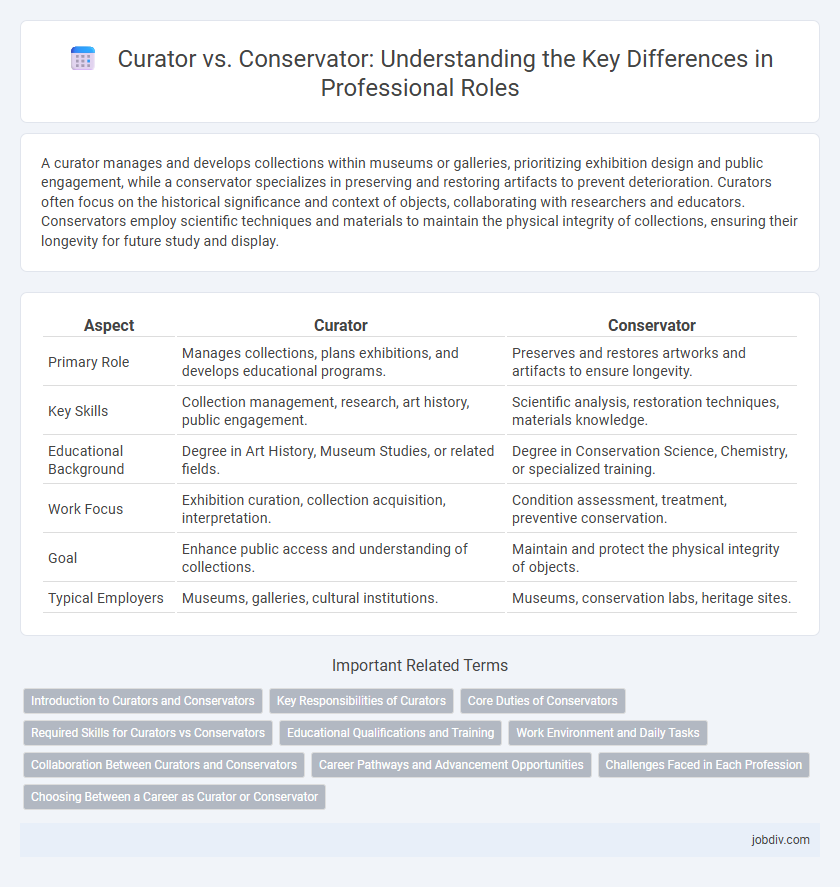A curator manages and develops collections within museums or galleries, prioritizing exhibition design and public engagement, while a conservator specializes in preserving and restoring artifacts to prevent deterioration. Curators often focus on the historical significance and context of objects, collaborating with researchers and educators. Conservators employ scientific techniques and materials to maintain the physical integrity of collections, ensuring their longevity for future study and display.
Table of Comparison
| Aspect | Curator | Conservator |
|---|---|---|
| Primary Role | Manages collections, plans exhibitions, and develops educational programs. | Preserves and restores artworks and artifacts to ensure longevity. |
| Key Skills | Collection management, research, art history, public engagement. | Scientific analysis, restoration techniques, materials knowledge. |
| Educational Background | Degree in Art History, Museum Studies, or related fields. | Degree in Conservation Science, Chemistry, or specialized training. |
| Work Focus | Exhibition curation, collection acquisition, interpretation. | Condition assessment, treatment, preventive conservation. |
| Goal | Enhance public access and understanding of collections. | Maintain and protect the physical integrity of objects. |
| Typical Employers | Museums, galleries, cultural institutions. | Museums, conservation labs, heritage sites. |
Introduction to Curators and Conservators
Curators manage and develop art collections by organizing exhibitions, conducting research, and acquiring works that align with the institution's goals. Conservators specialize in the preservation and restoration of artifacts, using scientific methods to maintain the physical and aesthetic integrity of cultural heritage. Both roles are essential in museums and galleries, ensuring the longevity and accessibility of collections for public education and enjoyment.
Key Responsibilities of Curators
Curators are primarily responsible for acquiring, managing, and interpreting collections within museums or cultural institutions, ensuring that artifacts are properly cataloged and displayed to enhance public understanding. They conduct extensive research, develop educational programs, and organize exhibitions to contextualize collections and engage diverse audiences. Curators also collaborate with conservators to maintain the preservation standards of artifacts, balancing accessibility with long-term care.
Core Duties of Conservators
Conservators specialize in the preservation, restoration, and scientific analysis of artworks and cultural artifacts, ensuring their longevity and structural integrity. Their core duties involve meticulous examination, cleaning, treatment, and documentation of materials using advanced techniques to prevent deterioration. Conservators collaborate with curators to develop preservation strategies, but their primary focus remains hands-on conservation and scientific intervention.
Required Skills for Curators vs Conservators
Curators require expertise in research, collection management, and public engagement to develop and interpret exhibits effectively. Conservators need specialized knowledge in materials science, chemistry, and hands-on restoration techniques to preserve and repair artifacts with precision. Both roles demand strong analytical skills, but curators emphasize cultural context while conservators focus on physical preservation.
Educational Qualifications and Training
Curators typically hold advanced degrees in fields like art history, museum studies, or archaeology, emphasizing research, collection management, and exhibition design. Conservators require specialized scientific training, often with degrees in chemistry, materials science, or conservation science, combined with hands-on internships for practical restoration skills. Both professions demand continuous education, but conservators focus more on technical preservation methods while curators prioritize scholarly knowledge and collection stewardship.
Work Environment and Daily Tasks
Curators typically work in museums, galleries, and cultural institutions, managing collections, organizing exhibitions, and conducting research to enhance public knowledge. Conservators operate in similar environments but focus on the preservation, restoration, and preventive care of artifacts, employing scientific techniques to ensure their longevity. Both roles require collaboration with specialists, but conservators spend more time in laboratories or controlled settings, while curators engage more with the public and educational programs.
Collaboration Between Curators and Conservators
Curators and conservators collaborate closely to preserve and interpret cultural heritage, combining expertise in collection management and material preservation. Curators provide historical context and research, guiding conservators in selecting appropriate conservation treatments that respect the artifact's integrity. This partnership ensures that objects are both properly maintained and meaningfully presented to the public.
Career Pathways and Advancement Opportunities
Curators typically focus on exhibition planning, collection management, and educational programming, making their career path ideal for those interested in art history, museum studies, or specialization in a particular collection. Conservators specialize in the scientific preservation and restoration of artifacts, requiring advanced training in chemistry, materials science, or conservation techniques, with career advancement often linked to expertise in specific conservation methods. Both roles offer opportunities for professional growth through certifications, advanced degrees, and leadership positions within museums or cultural institutions.
Challenges Faced in Each Profession
Curators face challenges in balancing exhibition design with educational goals while managing collections acquisition and provenance research. Conservators encounter difficulties in preserving artifacts with limited access to advanced restoration technologies and addressing material degradation caused by environmental factors. Both professions demand expertise in ethics and collaboration to ensure cultural heritage is safeguarded for future generations.
Choosing Between a Career as Curator or Conservator
Choosing between a career as a curator or conservator depends on your passion for either managing and interpreting collections or focusing on the preservation and restoration of artifacts. Curators prioritize collection development, exhibition planning, and public engagement, requiring strong research and communication skills. Conservators specialize in scientific techniques to maintain and repair objects, demanding expertise in chemistry, materials science, and hands-on restoration skills.
Curator vs Conservator Infographic

 jobdiv.com
jobdiv.com